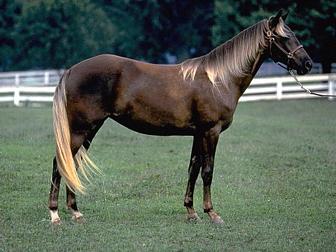
OVERVIEW
The Rocky Mountain Horse has the distinction of being one of the latest additions to the world's horse population. Developed in Kentucky, with the registry opening in 1986, this horse closely resembles its Spanish ancestors. Since the registry was opened the horse has seen steady development and refinement leading to today's distinctive breed.
PHYSICAL DESCRIPTION
Although a newer breed, the Rocky Mountain Horse has a distinct appearance closely related to the Spanish horses brought over to North America by the conquistadors. The most notable physical characteristic is the horse's unusual chocolate coat, most prized when accompanied by a flaxen mane and tail. Used mainly for the saddle, the horse's long and graceful neck contributes to its good balance. The horse stands between 14.2 and 15 hands with fairly low and flat whithers and the back curving up slightly to the croup. Although the shoulders are not heavily built, they are strong and well-placed. The hard and strong hooves lend themselves to the horse's sure-footed reputation. The large ears and handsome head give the horse an intelligent and alert look.
ORIGIN
The Rocky Mountain Horse, because of its recent development, can be traced back to a single sire: Old Tobe. Old Tobe was owned by Sam Tuttle of Stout Springs, Kentucky, who owned a riding concession at Natural Bridge State Park. This stallion was popular with riders because of his smooth and sure-footed amble or pace. His genes proved strong carrying on his conformation, action, and temperament to a large group of horses.
INTERESTING FACTS
Due to Old Tobe, the Rocky Mountain Horse's sire stallion, and his strong and fruitful genes, this breed has become known for its attractive coloring and its gait. Old Tobe was popular because of his comfortable ride, it, in turn, due to his smooth lateral gait. The breed now ambles smoothly on rough ground at 7 mph and, over short distances, can reach speeds up to 16 mph.
INFLUENCES
1. Spanish Mustang
For more information:
Rocky Mountain Horse Association
Listed as "Rare" by The American Livestock Breeds Conservancy (2004)